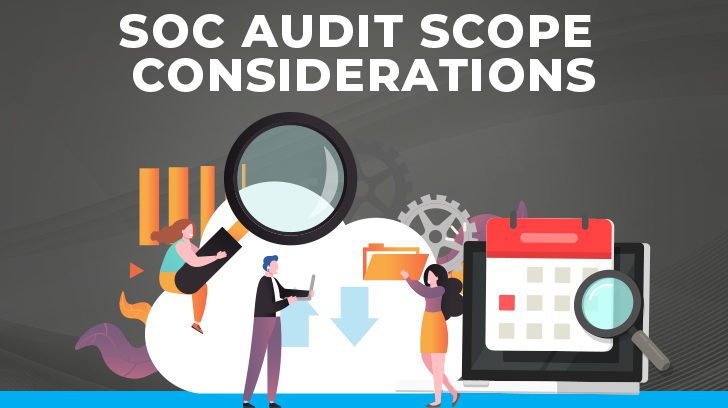Defining the scope of a SOC (System and Organization Controls) assessment is often the starting point for any meaningful audit preparation. The scope is critical because it determines which systems, services, and periods will be evaluated, impacting the value and usefulness of the SOC audit report to stakeholders. In this article, we’ll walk through essential questions and considerations that will help you establish a focused and effective scope for your SOC assessment.
What Does the Audit Scope Include?
When setting the audit scope, it’s important to start with the basics: Which systems, services, locations, and processes are truly relevant to the SOC assessment? Organizations often make the mistake of either over-scoping (which can make the process more complex and costly) or under-scoping (which can leave critical risks unaddressed). The ideal scope strikes a balance between comprehensive coverage and targeted focus.
For example, if you have an in-house data center and a third-party cloud service provider, both may be relevant to the scope if they process sensitive or critical data. Including these ensures that vulnerabilities in these environments are addressed in your SOC report. For a more detailed look at scoping considerations, see our blog on navigating the scope of a SOC 2 audit.

What is the Scope of a SOC Report?
The scope of a SOC report is guided by the type of SOC report you need and the expectations of your stakeholders. A SOC 1 report, for instance, focuses on controls relevant to financial reporting, while a SOC 2 report addresses operational controls related to security, availability, processing integrity, confidentiality, and privacy.
- SOC 1 Report: Primarily intended for financial auditors concerned with controls over financial reporting.
- SOC 2 Report: A broader report aimed at clients or stakeholders interested in your organization’s security posture.
A clear understanding of the purpose of each report type can help guide scoping. For more details, check out our article on the differences between SOC 1 and SOC 2.
Who Determines the Scope of an Audit?
Typically, management has the responsibility within the organization to define the initial scope, with the assistance of auditors who bring knowledge of industry standards, regulatory requirements, and risk considerations. This collaboration can make the scoping process more effective and efficient. Setting the right scope involves a thoughtful review of systems, services, and periods most critical to your stakeholders and aligning with their expectations. Learn more about the benefits of SOC reports beyond compliance requirements.
Objectives & Criteria of Audit Scoping
The primary objectives of scoping are to ensure a comprehensive, targeted review and to set objective criteria that define what should and should not be covered. This requires an understanding of your organization’s risk profile, contractual obligations, and regulatory environment.
One organization, for instance, excluded a key third-party vendor from their scope, believing it wasn’t critical. However, they later expanded the audit to address data integrity concerns involving this vendor, after realizing it played a crucial role in their data processing chain.
Defining these scope objectives and criteria in advance helps prevent such oversights and provides clarity on why each system, service, or location is included.

How to Create an Audit Scope
Creating an effective audit scope requires structured planning and prioritization. Here’s a step-by-step approach to get you started.
- Identify Key Systems and Services: Begin by mapping out the systems and services that are integral to your operations, especially those directly impacting financial reporting (SOC 1) or security and confidentiality (SOC 2).
- Consider Audit Coverage: Include all relevant systems and services, and think critically about whether to include multiple services (such as both on-premises and cloud services) and systems managed by third parties. For more guidance on managing cloud considerations, see our article on auditing cloud services.
- Define the Audit Period: Choose an audit period that aligns with your operational cycles, contractual commitments, or regulatory requirements. Audit periods can range from several months to a full year, depending on the organization’s needs.
- Establish User Reliance: Keep in mind the end users of the SOC report. For instance, a client’s bank might rely on the SOC 2 report to ensure your organization’s controls meet their expectations for data security and availability.
- Document Complementary Services: Identify any third-party services that play a role in your internal controls and verify that their assessment is included if relevant. For more guidance, refer to our article on vendor and third-party risk management.
What Type of Systems Should Be Audited?
The systems that need to be audited are those directly affecting the service being assessed. This often includes critical internal systems as well as any third-party services involved in delivering your organization’s services or storing data.
For example, in a healthcare organization, an electronic medical records system and associated data processors are critical and should be included in the audit scope to meet regulatory health data protection standards. This process ensures that both organizational and third-party systems are accounted for in the scope, preventing gaps in the SOC report.

Auditing Multiple Systems & Services
In today’s business environment, it’s common for organizations to depend on a mix of internal applications, cloud services, and outsourced vendors. Including multiple systems and services in the audit helps you gain a holistic view of your controls across different environments.
A global organization, for example, might include its data centers in different regions to address security controls across its international branches. Similarly, if your organization relies on a third-party data backup provider, including this vendor in your SOC audit scope provides assurance that backup and recovery processes are appropriately managed.
Audit Coverage & Audit Reliance
- Audit Coverage: Defines the extent of systems and services included in the audit. Audit coverage is crucial to verify that no major gaps exist in the SOC report.
- Audit Reliance: Refers to how much trust stakeholders place in the findings of the SOC report. For example, a SOC report from an IT service provider may provide your financial institution’s customers with confidence in the security of their data.
If audit reliance is high, it’s even more critical that the SOC report’s scope aligns closely with stakeholders’ needs. Read here for more insights on whether or not you need a SOC report.
Key Takeaways for SOC Audit Scope Planning
Defining the scope of your SOC assessment is a crucial step that impacts the value and credibility of the report. By prioritizing audit coverage, aligning the audit period, addressing user reliance, and including complementary services, you can create a focused and comprehensive scope that meets the needs of your stakeholders.
In summary:
- The audit scope should encompass all relevant systems, services, and third-party providers.
- The SOC report scope is guided by the intended users and rooted in regulatory or contractual requirements.
- Scoping is a collaborative process that often requires input from auditors, as well as management.
- Audit coverage helps prevent gaps in the report, while audit reliance reflects the level of confidence stakeholders can place in the SOC assessment.
Through thoughtful scoping, organizations can produce a SOC report that builds confidence, meets compliance, and supports operational goals.
If you’re considering a SOC audit or have questions about the scoping process, don’t hesitate to contact Linford & Company. Additionally, feel free to reach out to me directly if you would like more personalized guidance with your SOC 1 or SOC 2 assessment, or to learn more about our comprehensive audit services.

Isaac Clarke is a partner at Linford & Co., LLP. He began his career with Ernst & Young in 2003 where he developed his audit expertise over a number of years. Isaac specializes in and has conducted numerous SOC 1 and SOC 2 examinations for a variety of companies—from startups to Fortune 100 companies. Isaac enjoys helping his clients understand and simplify their compliance activities. He is attentive to his clients’ needs and works meticulously to ensure that each examination and report meets professional standards.




